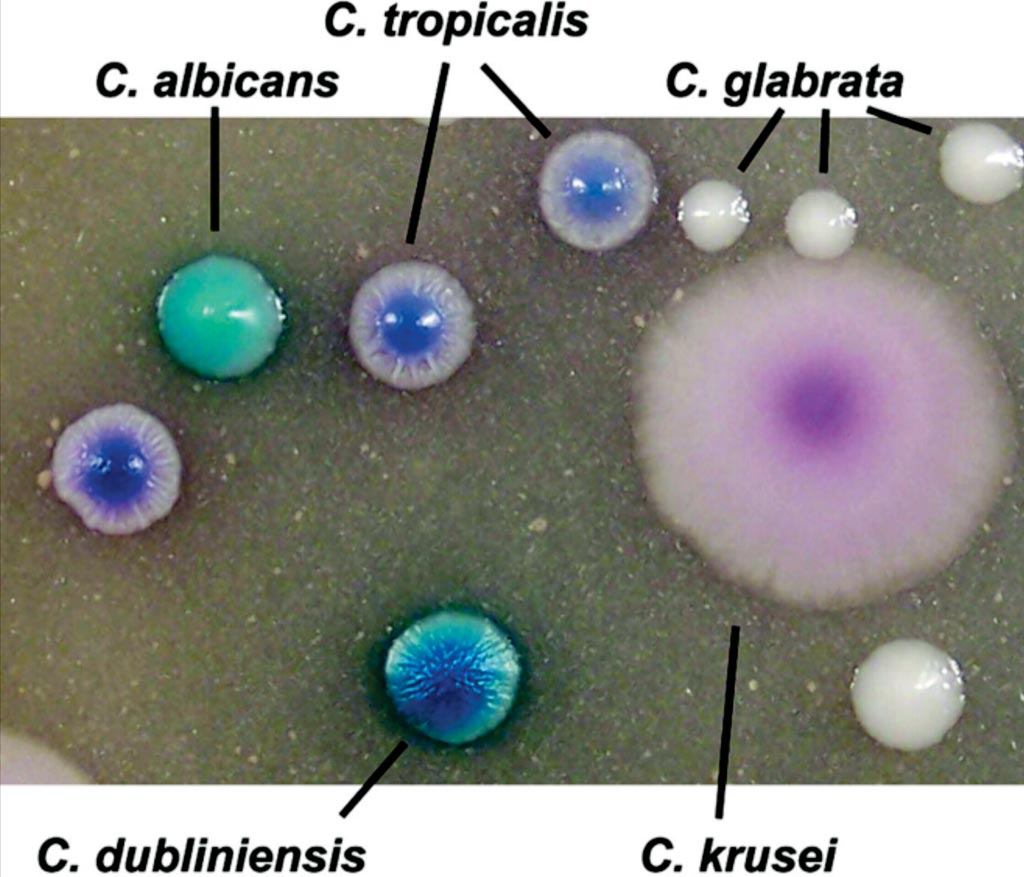Oral Yeasts from Cancer Patients Identified by MALDI-TOF
By LabMedica International staff writers
Posted on 23 Jan 2018
The most predominant yeasts isolated from oral colonization and infections are Candida species that are the most important opportunistic fungal pathogens in humans and cause mucosal to deep-seated candidiasis. Opportunistic infections due to Candida species occur frequently in cancer patients because of their inherent immunosuppression.Posted on 23 Jan 2018
The incidence of mild to severe fungal infections (FI) has dramatically increased in the last several decades, especially in patients infected with human immunodeficiency virus (HIV), those that use prolonged broad-spectrum antibiotics, patients undergoing hematopoietic stem cell transplantation (HSCT), and those receiving intensive chemo- and /or radiotherapy.

Image: Colonies of different species of Candida after growing for 48 hours at 37 °C in CHROMagar Candida medium supplemented with Pal\'s agar (Photo courtesy of the American Society of Microbiology).
Scientists at Mazandaran University of Medical Sciences (Sari, Iran) obtained 350 oral swab samples from cancer patients undergoing intensive chemotherapy, namely 210 (60%) males and 140 (40%) females and ranging 17 to 88 years in age with and without sign and symptoms of oral infection, including white plaque, erythematous and ulcerative lesions, dryness, pain, altered taste sensation and halitosis.
Specimens from cotton swabs were initially inoculated on malt extract agar supplemented with chloramphenicol and CHROMagar Candida medium. Strains were preliminarily identified using conventional methods, such as germ tube tests, formation of pseudohyphae, production of chlamydospores and carbohydrate assimilation tests using the ID 32 C kit. All strains were identified by polymerase chain reaction- restriction fragment length polymorphism (PCR-RFLP) and using the amplified Hyphal wall protein 1(HWP1) gene to distinguish members of the C. albicans complex. Matrix Assisted Laser Desorption/Ionization-time-of-flight mass spectrometer (MALDI-TOF M)S-based identification of all yeast and yeast-like isolates was performed according to Bruker Daltonics.
The scientists reported that among 162 yeasts and yeast-like fungi isolated from the oral cavity of cancer patients, Candida albicans was the most common species (50.6%), followed by Candida glabrata (24.7%), Pichia kudriavzevii (Candida krusei (9.9%)), Candida tropicalis (4.3%), Candida dubliniensis (3.7%), Kluyveromyces marxianus (Candida kefyr (3.7%)) and Candida parapsilosis (1%). Oral colonization by C. albicans, non-albicans Candida species and uncommon yeasts were as follow; 55%, 44% and 1%, whereas oral infection due to C. albicans was 33.3%, non-albicans Candida species 60.6%, and uncommon yeasts 6.1%.
The authors concluded that the incidence of oral candidiasis was higher amongst patients with hematological malignancies. The majority of oral infections were caused by non-albicans Candida species which were often more resistant to anti-fungal agents. Their findings suggest that anidulafungin should be used as antifungal of choice for prophylaxis in clinically high-risk patients with documented oral colonization or infection. The study was published on January 8, 2018, in the journal BMC Infectious Diseases.
Related Links:
Mazandaran University of Medical Sciences








 (3) (1).png)





